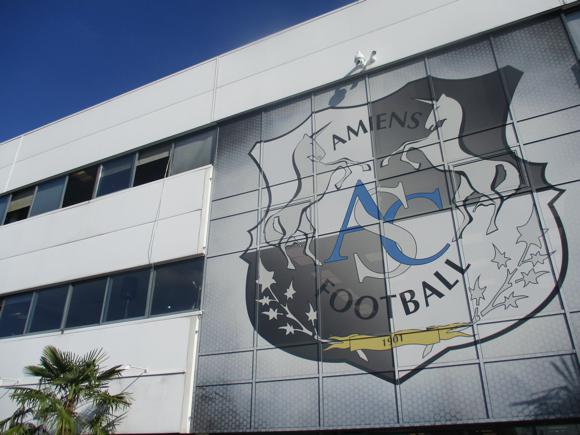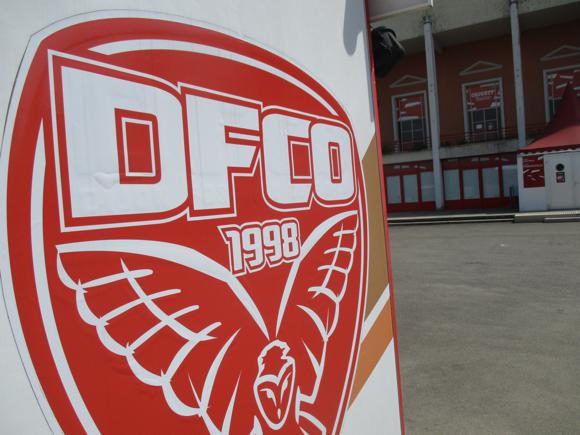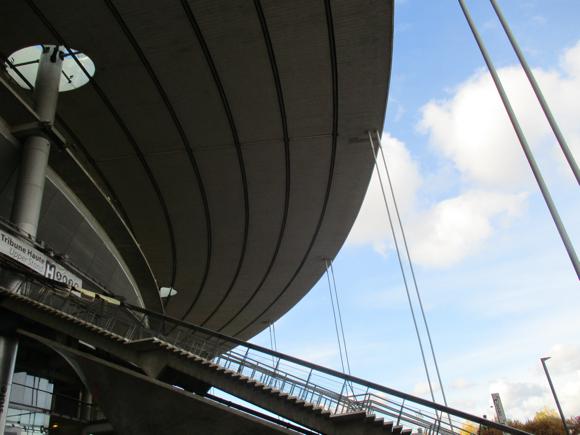A fan’s guide – the club from early doors to today
International aerospace hub Toulouse is also a prestigious rugby capital. Yet despite only a modest haul of trophies, including the Coupe de France in 2023, flagship football club Toulouse FC remain a popular local institution.
Toujours debout runs the slogan on the fluttering flags lining the bridge linking to Le Stadium, island home of TFC (‘TéFéCé’). ‘We’re still standing’, they proclaim, pointing to the various times in recent history when the club was on its knees.
In 2020, the Violets were relegated for the first time in two decades, and looked in dire straights until RedBird Capital stepped in to refinance the club, pushing them back into Ligue 1 and, ultimately, into Europe in 2023.
In 2001, they were salvaged then sent into back into Europe by a man who made his fortune in airline catering. That time, it was Toulouse-born Olivier Sadran who stepped in to save his home-town club. TFC duly qualified for both European tournaments, including a debut season in the Champions League in 2007-08.



Formed in 1937, the first Toulouse Football Club won the French Cup 20 years later. The 6-3 win over Angers included two goals from René Dereuddre, the star forward of the day.
In 1961, entrepreneur Jean-Baptiste Doumeng took over the club. This former Résistance fighter, who made his millions doing business with Communist Europe, gradually replaced the 1950s side with players such as striker Edmond Baraffe.
Though keeping Toulouse in the top half of the top flight, even making the Fairs Cup, Doumeng had overspent his budget. A misjudged amalgamation with Red Star in Paris came to nothing, except for Baraffe’s transfer there. Toulouse Mark I folded, with the consequence of the French FA permitting clubs to amalgamate only within a close distance of each other.
A new club emerged from Union Sportive Toulouse, formed in 1970 and a regular fixture in Ligue 2 for most of that decade. UST became Toulouse FC, and professional, before 1979-80.



French internationals Philippe Bergeroo, Guy Lacombe and Yannick Stopyra came on board after TFC’s subsequent promotion to Ligue 1. Along with three top-five finishes, the highlight of the decade, perhaps the club’s history, was a penalty shoot-out win over Maradona’s Napoli in 1986, Diego himself missing the vital spot-kick.
Despite the arrival of an ageing Dominique Rocheteau and a young Fabien Barthez, TFC slipped down the table. Financial troubles haunted the 1990s.
In 2001, new owner Olivier Sadran again reformed the professional status of the club, forced to restart in the third flight. Within two years, TFC had jumped up two flights.
It took the hiring of coach Élie Baup – and burly Swedish striker Johan Elmander – for Toulouse to match their achievements of the 1980s. The later Bolton goalgetter scored a hat-trick for TFC to beat Bordeaux en route to a Champions League debut in 2007.



Pitted against Liverpool, TFC held the Reds to a solitary goal in the August heat of Le Stadium but fell 4-0 at Anfield. European form hardly improved in the subsequent UEFA Cup.
With goals from André-Pierre Gignac, TFC returned to Europe in 2009-10, a late goal from Bruges putting paid to their Europa League hopes. The campaign was marred by the beating to death of TFC supporter Brice Taton by Serbian hooligans in Belgrade before the game with Partizan. A plaque is mounted in his memory at Le Stadium.
TFC continued to stay afloat in Ligue 1, despite selling Moussa Sissoko to Newcastle and Étienne Capoue to Spurs. Goals from attacking midfielder Wissam Ben Yedder saved many a day in the disappointing campaign of 2014-15.
An extra-time win over Marseille to reach the semi-final of the League Cup in 2016 was a rare highlight of a mediocre decade – along with victory over Ajaccio in a relegation play-off in 2018. In the pandemic season of 2019-20, after a dismal run under Antoine Kombouaré, the inevitable happened and TFC slipped down to Ligue 2.



And that’s where they would have stayed, had they survived, but for the intervention of RedBird Capital that same summer. With links to major sporting concerns across the States, the new owners kept Olivier Sadran as a junior partner but began introducing marketing techniques – the Debout Toujours slogans everywhere, for example – and introduced family-friendly pre-match entertainment on the stadium concourse.
Each buvette kiosk around the ground was dedicated to a special moment from TFC’s history, something to ponder as you queued for your sandwich. The home end, the Virage Brice Taton, belted out songs (‘Se Chanto…’) in local Occitan and a sense of pride returned to Le Stadium.
On the pitch, under former TFC goalkeeper Philippe Montanier, Toulouse gained promotion in 2022, former MK Dons striker Rhys Healey hitting a purple patch for the Violets in the run-up to Christmas. Back in Ligue 1, TFC were frustratingly inconsistent, though put together a run in the Coupe de France.



The Dutch pair of midfielder Branco van den Boomen and striker Thijs Dallinga came to the fore in high-scoring wins as a day in the sun at the Stade de France beckoned. Playing before 78,000, TFC went 4-0 up over Nantes on the half-hour, and would soon lift their first major silverware since a previous iteration of the club won the same trophy in 1957.
Manager Montanier was rewarded with the sack for his troubles, as TFC prepared for a first European campaign since 2009. Bringing in Carles Martínez Novell, his former head of methodology but someone who had never coached a senior side before, the club’s US owners were taking a huge risk.
So it proved, when a low-scoring Toulouse put together a string of draws in the league and were overwhelmed by Liverpool in the Europa League, 5-1 at Anfield. With only 18 clubs now in Ligue 1, a relegation battle seemed a likely scenario for Toulouse come spring 2024.







Stadium Guide
The field of dreams – and the stands around it






The Stadium de Toulouse, known as ‘Le Stadium’, was built for the 1938 World Cup. Due to stage one first round match, it ended up hosting two as Cuba’s game with Romania went to a replay after a 3-3 draw. Then it was also referred to as the Stade Chapou – today the name of a swimming pool north of Île du Grand Ramier, the island that had hosted local sports since the 1920s.
Attendances for the two games were just under 10,000. Yet Le Stadium was not even complete – this only happened after World War II.
Regularly filled with crowds of 30,000 plus for big rugby matches, Le Stadium came to life for the round-ball game in the 1980s, and the visits of Maradona’s Napoli and Rinat Dassayev’s Spartak Moscow.
Overlooked for Euro ’84, Toulouse improved on its functional appearance with it came to France ’98. Out went the pillars and roof, in came a natural light and a metallo-textile covering. Capacity crept up to 37,000, neutrals enjoying late goals by Romania’s Dan Petrescu and Holland’s Edgar Davids to settle vital ties against England and Yugoslavia respectively.





Another €40 million was invested to bring facilities further up to scratch for Euro 2016. Capacity is now 33,150, less than the 35,000 originally envisaged, a slight downsizing of the revamp as budget strings were tightened.
Local architects Cardete & Huet, aka Amsycom, were part responsible for the work, which saw the lower part of the stands knocked down and rebuilt for four games, including Wales’ 3-0 demolition of Russia. Le Stadium is also used as a major concert venue.
Home fans in the Virage Est, named after TFC fan Brice Taton who lost his life in Belgrade, fill the east end of the ground with colour and songs in local Occitan.
Away fans are usually allocated a sector in the Virage Ouest and/or given a limited number of places in a far end of the Honneur Nord. Neutrals are best accommodated in the Honneur Nord or Sud along the long sidelines.
getting here
Going to the stadium – tips and timings





A stop on tramway line T1, Croix de Pierre, is a short walk over the water to the stadium. It’s two stops from Arènes and four from Palais de Justice on the same T1 line.
On match days, free buses also shuttle from Arènes tramway stop, which links with red metro line A, and the city’s train station of Matabiau and bus station alongside.
Empalot and St-Michel Marcel Langer stations on yellow metro line B are about a 10-15min walk from the stadium, directly linked with Matabiau and its Marengo-SNCF metro stop outside. On the same line is Jean Jaurès, which also connects with the Airport Shuttle bus.
getting in
Buying tickets – when, where, how and how much


Availability is rarely a problem at Toulouse FC. Several agencies distribute online, including Ticketmaster and Fnac. In town, TFC have an outlet on the top floor of the MIDICA department store (Mon-Sat 9.30am-7.30pm) by Esquirol metro.
At Le Stadium, the Boutique/Billetterie (Tue, Thur & Fri 11am-3pm, Wed 11am-5pm, non-match Sat 10am-12.30pm, 2pm-6pm) is behind the Honneur Nord by the main road. It also opens 2hrs before kick-off.
Ticket prices start at around €12 in the cheapest Virages Haut behind the goals, €15 in the Virages Bas, €20 in the Honneur Sud and €25-plus in the Honneur Nord.
What to buy
Shirts, kits, merchandise and gifts




Among the replica shirts, Patrick Boudreault’s beautifully illustrated history of TFC since 1937 merits investigation at La Boutique Officielle (daily 9.30am-5pm, match days vary), the club’s main merchandise outlet facing the main concourse of Le Stadium.
The current version of the home kit features stripes in violet and white, the away top have stripes in alternate shades of purple, while the third-choice strip is white with faint diamonds of violet in the background.
Where to Drink
Pre-match beers for fans and casual visitors






For a pre-match swiftie a 15-20min walk from the stadium, towards St-Michel Marcel Langer metro, Le Biergarten on main Grande Rue St-Michel is just that, a huge beer garden filled with house plants, atmospherically winterised for part of the football season. Quality Bavarian wheat beers number among the many draught options, while the whole mess of Wurst that fills the Munich platter should keep you replete long after the final whistle.
Right by the metro station, the Tower of London is another in the Wells & Co chain of Brit-style pubs, the beer brewed in Bedford, matches shown on big screens.
L’Évasion shows games, hosts DJs and serves craft beer. Opened back in 1990, nearby Dubliners (46 avenue Marcel Langer) also screens matches and gets ‘em dancing with live music.
Those with time on their hands might want to pop into Le Rowing Club first, tucked away on the northern tip of the island, further from the stadium but worth an idle hour by the waterfront. Established in 1946, it’s an upscale retreat where they’re happy to serve you a glass of wine or beer at mealtimes. Closed between 3pm and 7pm.







If you’re coming by tram on the Croix de Pierre side of the stadium, and a sit-down meal’s what you’re after, look for a table in the relaxed garden of Le Troquet Garonne, a quality restaurant serving local and seasonal specialities. You’ll find it just across from the tram stop. Round the corner towards the stadium, the more simple fare of fried chicken at L’Ergot provides fans with a familiar fill-up.
Across the street, Le Chorus is by far the best pre-match option, a music venue and party destination whose location within sight of the stadium over the water means it pushes the boat out on game days. DJs spin and smokers puff away nervously in the enclosed back courtyard and wall garden, upturned barrels doubling up as tables. It’s just as lively post-match and you might catch a decent live act if you stick around long enough. Great staff, too.
Next door, Le Mambikas serves African dishes (€15-€20) in informal, bar-like surroundings that lend themselves perfectly to the quality live jazz also staged here.









Le Stadium is set in a recreational zone on an island – there are no bars immediately alongside but match days are like a food-truck festival, with mobile outlets ringing the ground. Look out for Giordano, a charcuterie set up by the husband-and-wife team of Daniel and Colette at Mazères market back in 1970 and still proffering prime sausages and fine foie gras, which sets up between the club shop and the Virage Brice Taton home end. Here, facing sectors 4-7, big queues fan out from a row of outlets.
On the other side of the stadium, with fewer crowds, La Guinguette serves classic French snacks and drinks from its distinctive yellow van. Le Marché, a stand-alone chalet by the bridge, offers local specialities, while the violet-coloured drinks kiosks, buvettes, dotted around the ground each display a classic moment from TFC history.
Pride of place goes to La Bodega, across from sector 11 behind the Honneur Sud stand – walk up the steep metal staircase to access it. Overlooking the home end, it serves standard lagers (blonde de soif) by the half, pint or pitcher at €25, including a €4 deposit for the jug. The bar is to your right as you walk in – facing it, the food counter dispenses croque sandwiches.
































